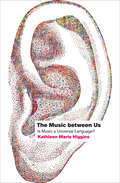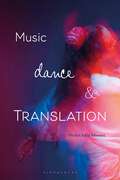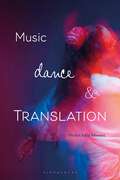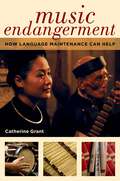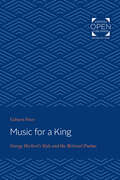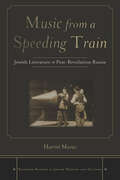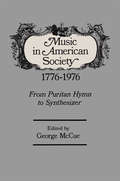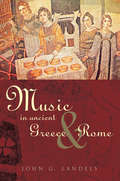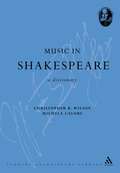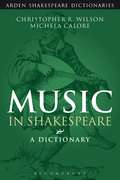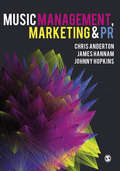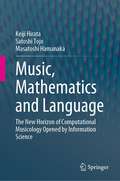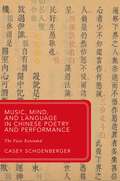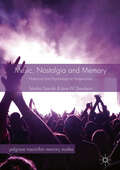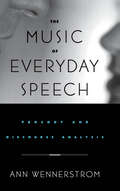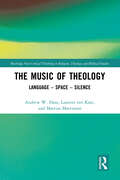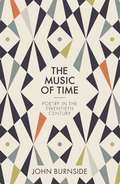- Table View
- List View
The Music between Us: Is Music a Universal Language?
by Kathleen Marie HigginsFrom our first social bonding as infants to the funeral rites that mark our passing, music plays an important role in our lives, bringing us closer to one another. In The Music between Us, philosopher Kathleen Marie Higgins investigates this role, examining the features of human perception that enable music’s uncanny ability to provoke, despite its myriad forms across continents and throughout centuries, the sense of a shared human experience. Drawing on disciplines such as philosophy, psychology, musicology, linguistics, and anthropology, Higgins’s richly researched study showcases the ways music is used in rituals, education, work, healing, and as a source of security and—perhaps most importantly—joy. By participating so integrally in such meaningful facets of society, Higgins argues, music situates itself as one of the most fundamental bridges between people, a truly cross-cultural form of communication that can create solidarity across political divides. Moving beyond the well-worn takes on music’s universality, The Music between Us provides a new understanding of what it means to be musical and, in turn, human.
Music, Dance and Translation
by Helen Julia MinorsHow is music affected by its translation, interpretation and adaptation with, through, and by dance? How might notation of dance and music act as a form of translation? How does music influence the creation of dance? How might dance and music be understood to exchange and transfer their content, sense and process during both the creative process and the interpretative process? Bringing together chapters that explore theory and practice, this book questions the process and role translation has to play in the context of music and dance. It provides a range of case studies across this interdisciplinary field, and is not restricted by genre, style or cultural location. As one of very few volumes to explore translation in relation to music and to overtly tackle this topic in terms of dance, it moves the argument from a broad notion of text and translation, to think critically about the sound and movement arts of music and dance, using translation as a model to better understand the collaboration of these art forms.
Music, Dance and Translation
How is music affected by its translation, interpretation and adaptation with, through, and by dance? How might notation of dance and music act as a form of translation? How does music influence the creation of dance? How might dance and music be understood to exchange and transfer their content, sense and process during both the creative process and the interpretative process? Bringing together chapters that explore theory and practice, this book questions the process and role translation has to play in the context of music and dance. It provides a range of case studies across this interdisciplinary field, and is not restricted by genre, style or cultural location. As one of very few volumes to explore translation in relation to music and to overtly tackle this topic in terms of dance, it moves the argument from a broad notion of text and translation, to think critically about the sound and movement arts of music and dance, using translation as a model to better understand the collaboration of these art forms.
Music for a King: George Herbert's Style and the Metrical Psalms
by Coburn FreerOriginally published in 1972. This book tries to study the affinities in form and matter between the versified translation of the Psalms and George Herbert's lyrics. Coburn Freer reads Herbert's poetry by way of the metrical psalms that precede it, proposing a reading that could be applied to more poems than are discussed here. Rather than multiply examples needlessly, this book stresses a few central poems as models or representatives. This reading of Herbert recognizes the historical dimension of his poems, but the author does not make that dimension the only significant one in the determination of poetic meaning or value.
Music for a King: George Herbert's Style and the Metrical Psalms
by Coburn FreerOriginally published in 1972. This book tries to study the affinities in form and matter between the versified translation of the Psalms and George Herbert's lyrics. Coburn Freer reads Herbert's poetry by way of the metrical psalms that precede it, proposing a reading that could be applied to more poems than are discussed here. Rather than multiply examples needlessly, this book stresses a few central poems as models or representatives. This reading of Herbert recognizes the historical dimension of his poems, but the author does not make that dimension the only significant one in the determination of poetic meaning or value.
Music from a Speeding Train: Jewish Literature in Post-Revolution Russia (Stanford Studies in Jewish History and Culture #180)
by Harriet MuravMusic from a Speeding Train explores the uniquely Jewish space created by Jewish authors working within the limitations of the Soviet cultural system. It situates Russian- and Yiddish- language authors in the same literary universe—one in which modernism, revolution, socialist realism, violence, and catastrophe join traditional Jewish texts to provide the framework for literary creativity. These writers represented, attacked, reformed, and mourned Jewish life in the pre-revolutionary shtetl as they created new forms of Jewish culture. The book emphasizes the Soviet Jewish response to World War II and the Nazi destruction of the Jews, disputing the claim that Jews in Soviet Russia did not and could not react to the killings of Jews. It reveals a largely unknown body of Jewish literature beginning as early as 1942 that responds to the mass killings. By exploring works through the early twenty-first century, the book reveals a complex, emotionally rich, and intensely vibrant Soviet Jewish culture that persisted beyond Stalinist oppression.
Music in American Society
by George McCueThis book is the literary legacy of a national music festival in St. Louis, organized to identify as clearly as possible the specifically native character of music originating in the United States of America. The festival—the Bicentennial Horizons of American Music and the Performing Arts (B.H.A.M.)—sponsored more than 250 performances and workshops between Flag Day and Independence Day 1976. It was the only event of the Bicentennial celebration to address itself to a survey and evaluation of the musical development of this country.
Music in American Society: From Puritan Hymn To Synthesizer
by George McCueThis book is the literary legacy of a national music festival in St. Louis, organized to identify as clearly as possible the specifically native character of music originating in the United States of America. The festival—the Bicentennial Horizons of American Music and the Performing Arts (B.H.A.M.)—sponsored more than 250 performances and workshops between Flag Day and Independence Day 1976. It was the only event of the Bicentennial celebration to address itself to a survey and evaluation of the musical development of this country.
Music in Ancient Greece and Rome
by John G LandelsMusic in Ancient Greece and Rome provides a comprehensive introduction to the history of music from Homeric times to the Roman emperor Hadrian, presented in a concise and user-friendly way. Chapters include: * contexts in which music played a role * a detailed discussion of instruments * an analysis of scales, intervals and tuning * the principal types of rhythm used * and an exploration of Greek theories of harmony and acoustics.Music in Ancient Greece and Rome also contains numerous musical examples, with illustrations of ancient instruments and the methods of playing them.
Music in Ancient Greece and Rome
by John G LandelsMusic in Ancient Greece and Rome provides a comprehensive introduction to the history of music from Homeric times to the Roman emperor Hadrian, presented in a concise and user-friendly way. Chapters include: * contexts in which music played a role * a detailed discussion of instruments * an analysis of scales, intervals and tuning * the principal types of rhythm used * and an exploration of Greek theories of harmony and acoustics.Music in Ancient Greece and Rome also contains numerous musical examples, with illustrations of ancient instruments and the methods of playing them.
Music in Shakespeare: A Dictionary (Continuum Shakespeare Dictionaries)
by Christopher R. Wilson Michela CaloreMusical references, allusions to music, and music stage directions abound in Shakespeare, ranging from simple trumpet flourishes to sophisticated, philosophical allegory. Music in Shakespeare: A Dictionary identifies all musical terms found in the Shakespeare canon. An A-Z of over 300 entries includes a definition of each musical term in its historical and theoretical context, and explores the extent of Shakespeare's use of musical imagery across the full range of his dramatic and poetic work. Music in Shakespeare also analyses the usage of musical instruments and sound effects on the Shakespearean stage, providing descriptions of the instruments employed in the Elizabethan and Jacobean theatres. This is a comprehensive reference guide for scholars and students with interests ranging from the thematic and allegorical relevance of music in Shakespeare's works to the history of performance. It is also aimed at the growing number of directors and actors concerned with recovering the staging conditions of the early modern theatre.
Music in Shakespeare: A Dictionary (Arden Shakespeare Dictionaries #Vol. 1)
by Christopher R. Wilson Michela CaloreWith an A-Z of over 300 entries, Music in Shakespeare is the most comprehensive study of all the musical terms found in Shakespeare's complete works. It includes a definition of each musical term in itshistorical and theoretical context, and explores the diverse extent of musical imagery across the full range of Shakespeare's dramatic and poetic work, as well as analysing the usage of instruments and sound effects on the Shakespearean stage. This is a comprehensive reference guide for scholars and students with interests in the thematic and allegorical relevance of music in Shakespeare, and the history of performance. Identifying all musical terms found in the Shakespeare canon, it will also be of use to the growing number of directors and actors concerned with recovering the staging conditions of the early modern theatre.
Music Management, Marketing and PR
by Chris Anderton James Hannam Johnny HopkinsThis book is your guide to the study and practice of music management and the fast-moving music business of the 21st century. Covering a range of careers, organisations, and practices, this expert introduction will help aspiring artists, managers, and executives to understand and succeed in this exciting sector. Featuring exclusive interviews with industry experts and discussions of well-known artists, it covers key areas such as artist development, the live music sector, fan engagement, and copyright. Other topics include: Managing contracts and assembling teams. Using data audits of platforms to adapt campaigns. Shaping opinions about music, musicians, events. How the music industry can be more diverse, inclusive, and equitable for the benefit of all. Working with venues, promoters, booking agents, and tour managers. Branding, sponsorship, and endorsement. Funding, crowdsourcing and royalty collection. Ongoing digital developments such as streaming income and algorithmic recommendation. Balancing the creative and the commercial, it is essential reading for students of music management, music business, and music promotion – and anybody looking to build their career in the music industries. Dr Chris Anderton, Johnny Hopkins, and James Hannam all teach on the BA Music Business at the Faculty of Business, Law and Digital Technologies at Solent University, Southampton, UK.
Music Management, Marketing and PR
by Chris Anderton James Hannam Johnny HopkinsThis book is your guide to the study and practice of music management and the fast-moving music business of the 21st century. Covering a range of careers, organisations, and practices, this expert introduction will help aspiring artists, managers, and executives to understand and succeed in this exciting sector. Featuring exclusive interviews with industry experts and discussions of well-known artists, it covers key areas such as artist development, the live music sector, fan engagement, and copyright. Other topics include: Managing contracts and assembling teams. Using data audits of platforms to adapt campaigns. Shaping opinions about music, musicians, events. How the music industry can be more diverse, inclusive, and equitable for the benefit of all. Working with venues, promoters, booking agents, and tour managers. Branding, sponsorship, and endorsement. Funding, crowdsourcing and royalty collection. Ongoing digital developments such as streaming income and algorithmic recommendation. Balancing the creative and the commercial, it is essential reading for students of music management, music business, and music promotion – and anybody looking to build their career in the music industries. Dr Chris Anderton, Johnny Hopkins, and James Hannam all teach on the BA Music Business at the Faculty of Business, Law and Digital Technologies at Solent University, Southampton, UK.
Music Management, Marketing and PR
by Chris Anderton James Hannam Johnny HopkinsThis book is your guide to the study and practice of music management and the fast-moving music business of the 21st century. Covering a range of careers, organisations, and practices, this expert introduction will help aspiring artists, managers, and executives to understand and succeed in this exciting sector. Featuring exclusive interviews with industry experts and discussions of well-known artists, it covers key areas such as artist development, the live music sector, fan engagement, and copyright. Other topics include: Managing contracts and assembling teams. Using data audits of platforms to adapt campaigns. Shaping opinions about music, musicians, events. How the music industry can be more diverse, inclusive, and equitable for the benefit of all. Working with venues, promoters, booking agents, and tour managers. Branding, sponsorship, and endorsement. Funding, crowdsourcing and royalty collection. Ongoing digital developments such as streaming income and algorithmic recommendation. Balancing the creative and the commercial, it is essential reading for students of music management, music business, and music promotion – and anybody looking to build their career in the music industries. Dr Chris Anderton, Johnny Hopkins, and James Hannam all teach on the BA Music Business at the Faculty of Business, Law and Digital Technologies at Solent University, Southampton, UK.
Music, Mathematics and Language: The New Horizon of Computational Musicology Opened by Information Science
by Keiji Hirata Satoshi Tojo Masatoshi HamanakaThis book presents a new approach to computational musicology in which music becomes a computational entity based on human cognition, allowing us to calculate music like numbers. Does music have semantics? Can the meaning of music be revealed using symbols and described using language? The authors seek to answer these questions in order to reveal the essence of music. Chapter 1 addresses a very fundamental point, the meaning of music, while referring to semiotics, gestalt, Schenkerian analysis and cognitive reality. Chapter 2 considers why the 12-tone equal temperament came to be prevalent. This chapter serves as an introduction to the mathematical definition of harmony, which concerns the ratios of frequency in tonic waves. Chapter 3, “Music and Language,” explains the fundamentals of grammar theory and the compositionality principle, which states that the semantics of a sentence can be composed in parallel to its syntactic structure. In turn, Chapter 4 explains the most prevalent score notation – the Berklee method, which originated at the Berklee School of Music in Boston – from a different point of view, namely, symbolic computation based on music theory. Chapters 5 and 6 introduce readers to two important theories, the implication-realization model and generative theory of tonal music (GTTM), and explain the essence of these theories, also from a computational standpoint. The authors seek to reinterpret these theories, aiming at their formalization and implementation on a computer. Chapter 7 presents the outcomes of this attempt, describing the framework that the authors have developed, in which music is formalized and becomes computable. Chapters 8 and 9 are devoted to GTTM analyzers and the applications of GTTM. Lastly, Chapter 10 discusses the future of music in connection with computation and artificial intelligence.This book is intended both for general readers who are interested in music, and scientists whose research focuses on music information processing. In order to make the content as accessible as possible, each chapter is self-contained.
Music, Mind, and Language in Chinese Poetry and Performance: The Voice Extended (Global Asias)
by Casey Schoenberger"Poetry puts intent into words; singing lengthens words"—this is one of the earliest Chinese comments on artistic expression. Poetic language extends the reach of a sentiment beyond the individual, and musicality extends the reach of poetic language, not only across a room, but across geography and generations. The "extended mind thesis" (EMT) views minds as extending beyond individual nervous systems to include material and social environments. Music, Mind, and Language in Chinese Poetry and Performance: The Voice Extended offers a comprehensive overview of the interwoven histories of traditional Chinese poetry and performing arts. It employs cognitive and quantitative methods such as EMT, and a database of over six thousand traditional melodies, to describe cyclical, continuous interactions between social minds and material artifacts. From the ancient Canon of Poetry to the song-lyrics (ci) of the late medieval period and the dramatic arias of Kun and Beijing operas, Casey Schoenberger introduces the rhythms, melodies, pronunciation, and grammatical stylistics of the major Chinese verse and performance traditions. In doing so, he gleans insights from cognitive neuroscience, digital humanities, musicology, and linguistics to explain not only the trajectory of Chinese arts, but also bigger phenomena, like vernacularisation and improvisation.
Music, Mind, and Language in Chinese Poetry and Performance: The Voice Extended (Global Asias)
by Casey Schoenberger"Poetry puts intent into words; singing lengthens words"--this is one of the earliest Chinese comments on artistic expression. Poetic language extends the reach of a sentiment beyond the individual, and musicality extends the reach of poetic language, not only across a room, but across geography and generations. The "extended mind thesis" (EMT) views minds as extending beyond individual nervous systems to include material and social environments. Music, Mind, and Language in Chinese Poetry and Performance: The Voice Extended offers a comprehensive overview of the interwoven histories of traditional Chinese poetry and performing arts. It employs cognitive and quantitative methods such as EMT, and a database of over six thousand traditional melodies, to describe cyclical, continuous interactions between social minds and material artifacts. From the ancient Canon of Poetry to the song-lyrics (ci) of the late medieval period and the dramatic arias of Kun and Beijing operas, Casey Schoenberger introduces the rhythms, melodies, pronunciation, and grammatical stylistics of the major Chinese verse and performance traditions. In doing so, he gleans insights from cognitive neuroscience, digital humanities, musicology, and linguistics to explain not only the trajectory of Chinese arts, but also bigger phenomena, like vernacularisation and improvisation.
Music, Nostalgia and Memory: Historical and Psychological Perspectives (Palgrave Macmillan Memory Studies)
by Sandra Garrido Jane W. DavidsonHow are our personal soundtracks of life devised? What makes some pieces of music more meaningful to us than others? This book explores the role of memory, both personal and cultural, in imbuing music with the power to move us. Focusing on the relationship between music and key life moments from birth to death, the text takes a cross-disciplinary approach, combining perspectives from a ‘history of emotions’ with modern day psychology, empirical surveys of modern-day listeners and analysis of musical works. The book traces the trajectory of emotional response to music over the past 500 years, illuminating the interaction between personal, historical and contextual variables that influence our hard-wired emotional responses to music, and the key role of memory and nostalgia in the mechanisms of emotional response.
The Music of Everyday Speech: Prosody and Discourse Analysis
by Ann WennerstromRecently there has been a growing interest among discourse analysts in incorporating prosody into the analysis of spoken language. Wennerstrom considers the role of prosody in a variety of discourse genres and offers an over-all framework within which future analysis might continue.
The Music of Theology: Language – Space – Silence (Routledge New Critical Thinking in Religion, Theology and Biblical Studies)
by Andrew Hass Mattias Martinson Laurens ten KateThis book reconceives theology as a musical endeavour in critical tension with language, space and silence. An Overture first moves us from music to religion, and then from theology back to music – a circularity that, drawing upon history, sociology, phenomenology, and philosophy, disclaims any theology of music and instead pursues the music in theology. The chapters that follow explore the three central themes by way of theory, music and myth: Adorno, Benjamin and Deleuze (language), Derrida, Rosa and Nancy (space), Schelling/Hegel, Homer and Cage (silence). In overdubbing each other, these chapters work towards theology as a sonorous rhythm between loss and freedom. A Coda provides three brief musical examples – Thomas Tallis, György Ligeti, and Evan Parker – as manifestations of this rhythm, to show in summary how music becomes the very pulse of theology, and theology the very intuition of music. The authors offer an interdisciplinary engagement addressing fundamental questions of the self and the other, of humanity and the divine, in a deconstruction of modern culture and of its bias towards the eye over the ear. The book harmonizes three scholarly voices who attempt to find where the resonance of our Western conceptions and practice, musically and theologically, might resound anew as a more expansive music of theology.
The Music of Theology: Language – Space – Silence (Routledge New Critical Thinking in Religion, Theology and Biblical Studies)
by Andrew Hass Mattias Martinson Laurens ten KateThis book reconceives theology as a musical endeavour in critical tension with language, space and silence. An Overture first moves us from music to religion, and then from theology back to music – a circularity that, drawing upon history, sociology, phenomenology, and philosophy, disclaims any theology of music and instead pursues the music in theology. The chapters that follow explore the three central themes by way of theory, music and myth: Adorno, Benjamin and Deleuze (language), Derrida, Rosa and Nancy (space), Schelling/Hegel, Homer and Cage (silence). In overdubbing each other, these chapters work towards theology as a sonorous rhythm between loss and freedom. A Coda provides three brief musical examples – Thomas Tallis, György Ligeti, and Evan Parker – as manifestations of this rhythm, to show in summary how music becomes the very pulse of theology, and theology the very intuition of music. The authors offer an interdisciplinary engagement addressing fundamental questions of the self and the other, of humanity and the divine, in a deconstruction of modern culture and of its bias towards the eye over the ear. The book harmonizes three scholarly voices who attempt to find where the resonance of our Western conceptions and practice, musically and theologically, might resound anew as a more expansive music of theology.
The Music of Time: Poetry in the Twentieth Century
by John BurnsideA revelatory and deeply personal history of twentieth-century poetry by prize-winning poet and memoirist John BurnsidePoetry helps us to make sense of our world, transforming what the Russian poet Osip Mandelstam called the "noise of time" into a kind of music. The Music of Time is a unique history of twentieth-century poetry by one of today's most acclaimed poets, blending incandescent personal meditations with rare insights about a broad range of poets who distilled the essence of the moment, gave voice to our griefs and joys, and shaped our collective memory.Bringing together poets from times and places as diverse as Tsarist Russia, 1960s Harlem, and Ireland at the height of the Troubles, Burnside reveals how poetry responded to the dramatic events of the century while shaping our impressions of them. He takes readers from the trenches of World War I to a prison cell in Nazi Germany, and from Rilke's grave in the Swiss Alps to Dylan Thomas's Welsh seaside. His luminous narrative is woven through with insights into the poet's creative process as well as lyrical and thought-provoking digressions on topics ranging from marriage to the Kennedy assassination.A spellbinding work of literary history, The Music of Time reveals how poets engaged with the most important issues and events of the twentieth century, and bears personal witness to the beauty and power of an art form unlike any other.
The Music of Time: Poetry in the Twentieth Century
by John BurnsideA revelatory and deeply personal history of twentieth-century poetry by prize-winning poet and memoirist John BurnsidePoetry helps us to make sense of our world, transforming what the Russian poet Osip Mandelstam called the "noise of time" into a kind of music. The Music of Time is a unique history of twentieth-century poetry by one of today's most acclaimed poets, blending incandescent personal meditations with rare insights about a broad range of poets who distilled the essence of the moment, gave voice to our griefs and joys, and shaped our collective memory.Bringing together poets from times and places as diverse as Tsarist Russia, 1960s Harlem, and Ireland at the height of the Troubles, Burnside reveals how poetry responded to the dramatic events of the century while shaping our impressions of them. He takes readers from the trenches of World War I to a prison cell in Nazi Germany, and from Rilke's grave in the Swiss Alps to Dylan Thomas's Welsh seaside. His luminous narrative is woven through with insights into the poet's creative process as well as lyrical and thought-provoking digressions on topics ranging from marriage to the Kennedy assassination.A spellbinding work of literary history, The Music of Time reveals how poets engaged with the most important issues and events of the twentieth century, and bears personal witness to the beauty and power of an art form unlike any other.
